UK DIY News
Retail Sales Rebounded In January

Data from the ONS has revealed that retail sales rebounded in January.
Retail sales volumes rose by 1.9% in January 2022 following a fall of 4.0% in December 2021 (revised down from a fall of 3.7%); sales volumes were 3.6% above their pre-coronavirus (COVID-19) February 2020 levels.
Non-food stores sales volumes rose by 3.4% in January 2022 as home improvement sales volumes picked up with increased sales in household goods and garden centres; non-food sales volumes were 1.1% below their February 2020 levels.
Automotive fuel sales volumes rose by 4.1% in January 2022 following a fall of 5.0% in December when increased home working and lower retail footfall reduced travel; sales volumes in January 2022 were 3.3% below their February 2020 levels.
Food store sales volumes in January 2022 fell below pre-coronavirus levels for the first time and were 0.8% below where they were in February 2020.
The proportion of retail sales online fell to 25.3% in January 2022, its lowest proportion since March 2020 (22.7%), continuing a broad downward trend since its peak in February 2021 (36.5%); despite its downward trend, the percentage of retail sales made online was still higher than before the coronavirus pandemic (19.8% in February 2020).
ONS Commentary
Responding to the latest ONS Retail Sales Index figures, which showed 11.6% year-on-year sales growth in January (value, non-seasonally adjusted retail sales excluding fuel: J3L2), Helen Dickinson, Chief Executive of the British Retail Consortium, said:
“Despite falling consumer confidence, retail sales held up well in January as retailers went to great lengths to keep up the Christmas momentum. Sales of non-food items, including clothing, furniture and household goods all grew by high double digits. Meanwhile, food sales dropped – though this is compared to January 2021, when most of the country was in lockdown and households were unable to eat out.
“Falling Covid cases and the slow return to offices offer further hope for town and city centres that were hardest hit by the pandemic. Yet, rising inflation means households may be preparing for future falls in disposable income, including from April’s National Insurance and energy price cap rises. Retailers face similar challenges, with increases in transport and energy costs, global commodity prices and domestic wages. While retailers are going to great lengths to mitigate or absorb these cost increases, it is inevitable that prices will rise further in the future.”
All changes are year-on-year, are non-seasonally adjusted, and are not adjusted for inflation
- All retailing, Excluding Automotive fuel, All businesses (J3L2): 11.6%
- All retailing, Excluding Automotive fuel, Large businesses (J3L3): 9.6%
- Predominantly Non-food Stores, All Businesses (EAIB): 40.1%
- Predominantly Non-food Stores, Large Businesses (EAIV): 41.6%
- Internet sales, all retail growth (KP3T): -20.0%
- Online penetration rate for all retail (J4MC): 27.1%
PwC Commentary
Commenting on the Office of National Statistics retail sales figures for January 2022, Lisa Hooker, consumer markets leader at PwC, said:
“January is never a normal month for retail, and this one is no exception, with both December and January’s sales depressed by Omicron and work from home restrictions. Therefore, care needs to be taken in reading too much into the headline retail sales increase reported today, with the 2% month-on-month value increase following a 3.4% decline last month. Overall sales are at least 9.1% ahead of pre-pandemic levels, albeit by only 3.6% on a volume basis, suggesting that inflation accounts for much of the increased spend.
“On a sector basis, the decline in grocery volumes can be explained by a normalisation in shopping activity as pandemic behaviours revert more to normal; fashion spending struggled as events were cancelled as a result of Omicron; and the increase in household goods and furniture sales suggests a return to the more usual new year pattern of investing in the home.
“There was also some respite for the high street as the proportion of online sales continued to abate from pandemic highs of over 36% to just 25%, partly as a result of softness in more online-friendly categories such as electricals and fashion.
“Not only is January atypical of wider shopping patterns, but it is also a relatively low spending month. So we can’t yet read much into what this means for the rest of 2022. What is certain is that the triple squeeze of cost of living increases, tax rises and interest rate hikes are for the most part yet to hit consumers’ wallets. The question for retailers is when this will hit spending, and which sectors will be most affected. They will certainly be bracing for the impending storm, and not just Storm Eunice.”
Source : ONS, BRC and PwC
Insight DIY is the only source of market information that I need and they always have the latest news before anyone else.











































